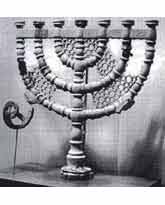What are the Circles on Either Side of the Menorah
David Amit

Reconstruction of the marble Menorah from Kh. Susiya
On the symbol of the Antiquities Authority, which is known to all of us, there appears a seven-branch candelabrum (menorah). This ancient Jewish symbol expresses the essence of the Authority, which is entrusted with the antiquities of the State of Israel. However, on the symbol of the Antiquities Authority, no olive branches appear on either side of the menorah as is the case on the symbol of the State of Israel; instead the menorah is flanked by two circles. It seems to me that except for a few people, the overwhelming majority of the authority’s employees, both veterans and recently hired alike, from the senior to the most junior of workers, do not know what is the significance of these circles. And therefore I have chosen to tell about them.
Our story begins at the end of the nineteenth century, when a German expedition excavated the Hellenistic city of Priene, located in Asia Minor (Turkey), and discovered a building dating from the Byzantine period which the excavators identified as a church. It was only many years afterwards, in light of the Jewish symbols that were found there, did scholars understand that the structure they thought was a church was actually a synagogue. Outstanding among the artistic details bearing Jewish symbols is the relief of a menorah, flanked on either side by a shofar and the four kinds of plants used to celebrate the Feast of Tabernacles. A spool is depicted on each side of the menorah’s main branch, between its feet and the secondary branches stemming off of it.
In 1934, Eliezer Lipa Sukenik, an authority on synagogues (and the father of Yigael Yadin), contended that these spools represent the ends of the torah scrolls. Sukenik found parallels for this in depictions of books placed on their side in a torah ark located in the Jewish catacombs (an underground burial complex) in Rome. Some thirty years after Sukenik published these opinions, a marble tablet similar to the relief from Priene and engraved with a menorah, lulav and shofar was discovered in the excavations of the ancient synagogue at Sardis, which is also in Asia Minor. Here too, there are two spools next to the main branch of the menorah. Following in Sukenik’s footsteps, Yigal Shiloh also interpreted the spools from Sardis as the ends of torah scrolls, although the similarity to scrolls is less apparent at Sardis than at Priene.
The menorah from Priene probably served as the model for our symbol but when they designed it they changed the spools (either knowingly or unknowingly) into just circles.
But the story does not end here. Since the establishment of the Antiquities Authority and the creation of its symbol, another three menorot with spools, also from Asia Minor, have been published. Based on five examples from Asia Minor, two Jewish art historians, Shimon (Steve) Fine and Leonard Rutgers, have concluded that menorot with spools “are regional types, the likes of which are not found elsewhere in the Roman-Byzantine world”. If this is indeed the case then the question arises as to whether it is not more appropriate to adorn the menorah that is on the symbol of an Israeli government authority with a Jewish symbol from the Land of Israel rather than a Jewish-‘Turkish’ motif? Before you lose any sleep out of fear we will have to change our symbol, I wish to reassure you with the following observation: Fine and Rutgers’ conclusions can be contradicted by two not-so-new discoveries of magnificent menorot that were found in the Land of Israel, and they too have spools.
The first is the relief of a menorah appearing on a marble tablet, several of whose fragments were discovered in 1969 in Horbat Koshet, east of Tivon. Below one of the fragments of the branches, and next to it, are the small remains of a circle. The second is a marble menorah in three dimensions, some of whose remains were discovered in the excavations of the synagogue at Horbat Susiya, at the beginning of the 1970’s. Among the fragments is one that is surprisingly reminiscent of the fragment from Horbat Koshet, that is to say, part of the bottom branch is flanked by part of a circle. Prior to the exhibition, “In the Light of the Menorah – The Story of a Symbol”, that was held about four years ago by the Israel Museum, in honor of the fiftieth anniversary of the State of Israel, the museum’s conservators labored assiduously to restore the menorot from Horbat Koshet and Horbat Susiya in order to prepare them for display. It was only then for the first time that one could fully appreciate the spools that were fashioned below the branches, based on the remains of the original spools on the fragments of the two menorot which are surprisingly similar when one considers the great distance between the sites of their provenance.
The end of the tale: the circles on our symbol are actually a transfiguration of spools. These spools, some of which were also made in the Land of Israel, represent torah scrolls, a Jewish motif that accompanies the seven branch menorah from the time of the Talmud until the present day.
Additional Articles ...